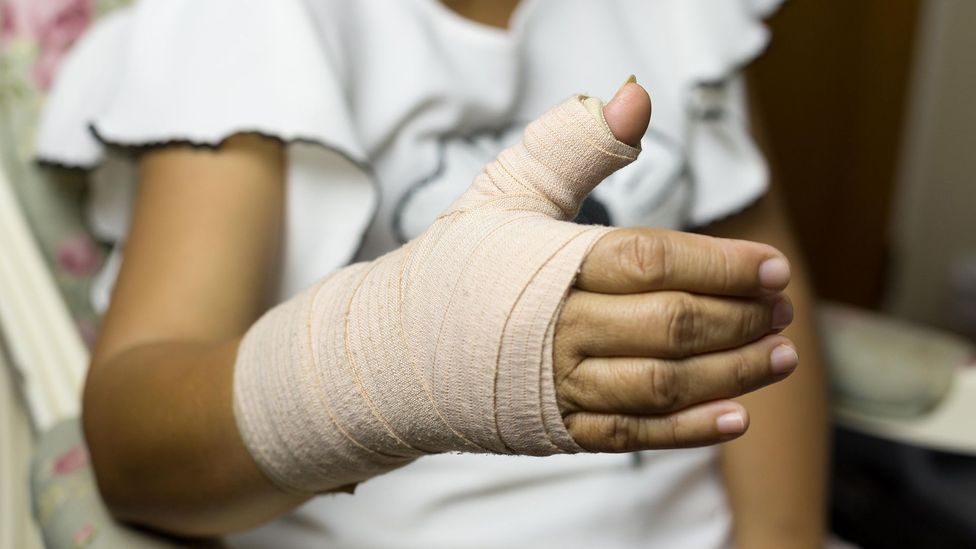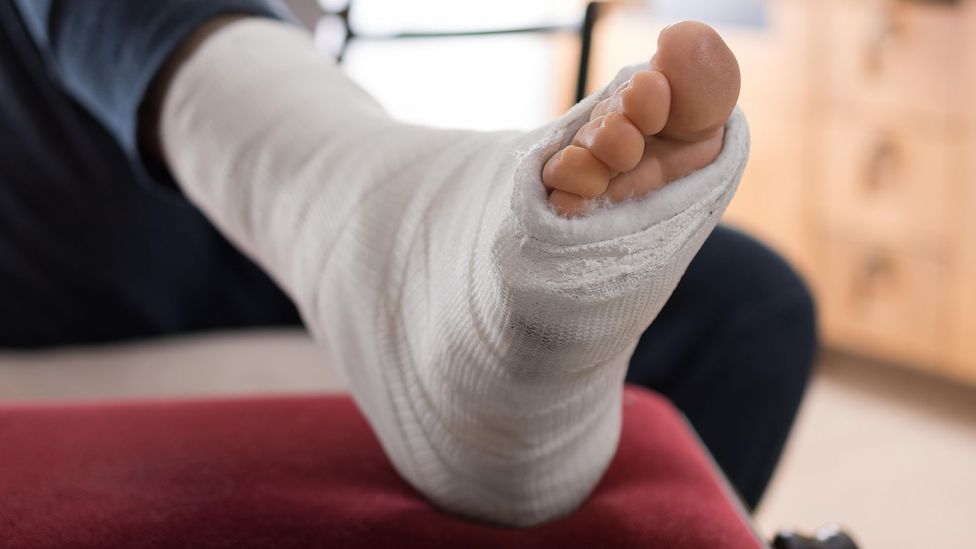Can I Break My Foot and Not Know It
Five myths about broken bones

Screaming, stabbing pain? Not always. You can move it, so it's not broken? Not all the time. Here, Claudia Hammond answers some of the myths about bone breaks.
I
If you can move it, it not's broken
It's the first thing someone usually says when you're writhing in agony after stubbing your toe really, really hard and are wondering if it might be broken. "Can you move it? In that case, you haven't broken it."
In fact, you can sometimes move a broken bone, so this is not one of the main signs to look for when deciding whether you have a fracture. The top three symptoms of a broken bone are pain, swelling and deformity. If a bone is sticking out at 90 degrees or poking through the skin, not surprisingly, that's not a good sign and it might well be broken. Another sign is if you heard a snap when the accident happened…
If it's broken you're inevitably in agony
Not necessarily. Plenty of people have tales to tell of tripping up, then spending the rest of the day skiing, walking or even dancing, without realising they had a fracture. More often than not, broken bones do hurt, a lot, but if a break is small you might not notice it. Once you do discover a bone is broken it's important to get professional help to ensure the bones are properly lined up and held in place while they heal, to avoid infection or permanent deformity.

Once you dicover a bone is broken, it's important to get treatment to make sure it heals properly (Credit: Alamy)
But there is a peculiarity when it comes to bone fractures and pain. It might not hurt at the time, but in 2015, using data from the UK Biobank of half a million adults, researchers at Southampton University found that people who had fractured their arm, leg, spine or hip in the past were more likely than other people to have widespread pain in the body decades later. Luckily this kind of pain is uncommon.
Older white women should worry about broken bones due to osteoporosis
Let's start with age. It's true that older women are more likely than younger women to suffer broken bones. The hormonal changes of the menopause can lead to rapid bone loss and the frequent fractures seen in osteoporosis.
You might also like:
- Are white teeth healthier?
- Is sparkling water bad for you?
- How often must we see a dentist?
When it comes to ethnicity, in the US there are more than twice as many hip fractures in white women than black women. A number of factors have been suggested to account for the increased bone strength in black women, including higher bone mass during childhood and a lower rate of bone turnover, which might lead to a slower decline in bone mineral density with age.
Having said that, black women can still suffer from osteoporosis. It's just that fewer of them do. Only 5% of black women above the age of 50 are thought to have osteoporosis, which has led for calls for symptoms in black women to be taken more seriously. In the US, for example, African American women are less likely to be referred for screening for osteoporosis than Caucasian women, and if they do receive a diagnosis they are less likely to be prescribed treatment.
There's no point in a seeing a doctor for broken toes because they can't do anything
It's true that you might not end up in plaster, but a broken toe still needs to be checked out. Medical staff need to establish the nature of the fracture to avoid long term pain or deformities, which might make shoes uncomfortable in the future or lead to arthritis later in life if a fracture hasn't healed smoothly. If the toe is at a weird angle after a break more complex treatment and even surgery might be needed.
Most broken toes can be taped to the toes either side and held steady in a special rigid shoe. Healing usually takes four to six weeks. Breaks in big toes are more serious and some people will need a cast up as high as the calf for two or three weeks, followed by taping to the second toe. Luckily big toes are half as likely to break as the other toes.

Most broken toes can be taped to the toes either side and held steady in a special rigid shoe (Credit: Alamy)
If it's the metatarsal – the next bone up from the toe – that's broken, fractures can still often heal without any kind of plaster as long as the foot is rested. This is because the bones on either side tend to hold each other straight, acting as a natural splint and in 80% of cases the bones remain in the correct place even when broken. But if there are wounds indicating an open fracture, or the bone won't go into rightful position, it might need treatment. This is more likely in the bone below the big toe because it doesn't have the support of the other bones holding it in place. Likewise, fractures of the bone below the little toe on the outside of the foot can sometimes require surgery or a cast.
Even if you don't need a cast, it's still worth getting broken toes treated. Once more serious fractures have been ruled out, staff can splint broken toes for you and dress them with soft padding. And they'll know whether you might benefit from crutches for a week or two until you can put your weight on it comfortably.
After a broken bone has healed, it's stronger than it was before
This sounds too good to be true and, in the long-term, it is too good to be true. But there is some truth to it in the short term. While healing, a cuff or callous of extra-strong new bone forms around the fracture to protect it. So, it is true that a few weeks into healing process, the bone at the break is stronger than a normal bone. But eventually this cuff diminishes, and a few years later you're left with a bone that might be as good as new, but is no stronger than the equivalent bones nearby.
--
Disclaimer
All content within this column is provided for general information only, and should not be treated as a substitute for the medical advice of your own doctor or any other health care professional. The BBC is not responsible or liable for any diagnosis made by a user based on the content of this site. The BBC is not liable for the contents of any external internet sites listed, nor does it endorse any commercial product or service mentioned or advised on any of the sites. Always consult your own GP if you're in any way concerned about your health.
Join 900,000+ Future fans by liking us on Facebook , or follow us on Twitter or Instagram .
If you liked this story, sign up for the weekly bbc.com features newsletter , called "If You Only Read 6 Things This Week". A handpicked selection of stories from BBC Future, Culture, Capital, and Travel, delivered to your inbox every Friday.
Can I Break My Foot and Not Know It
Source: https://www.bbc.com/future/article/20181005-five-myths-about-broken-bones
0 Response to "Can I Break My Foot and Not Know It"
Post a Comment